positive externalities, public goods, asymmetric info, inability to achieve equity
1/21
There's no tags or description
Looks like no tags are added yet.
Name | Mastery | Learn | Test | Matching | Spaced |
|---|
No study sessions yet.
22 Terms
positive production externalities
external benefits created by producers
eg: R&D efforts that lead to the spreading of productivity improvements
positive production externalities graph
when MSC < MPC
Qm < Qopt and MSB > MSC so the market is under-allocating resources and not enough is being produced
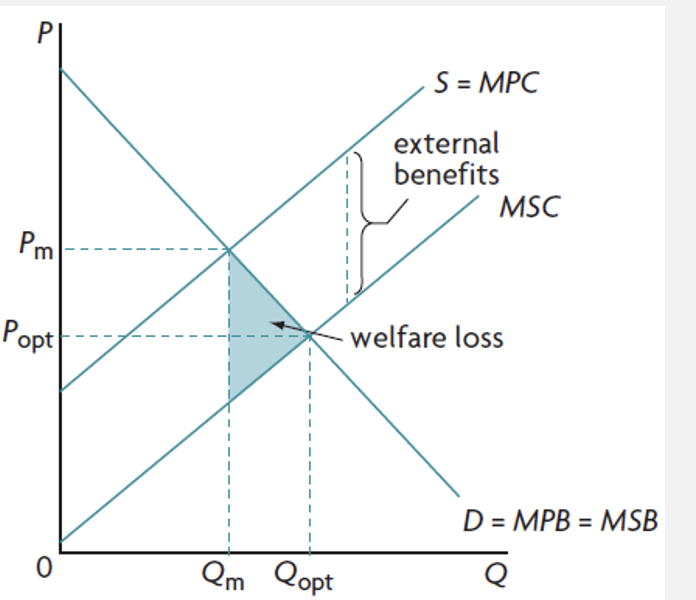
ways to correct PPE
direct govt provision: engaging in R&D or innovation in public companies or offer training to workers. can be done using funds from taxes
subsidies: providing a subsidy equal to the external benefit to reduce costs of production and increase provision
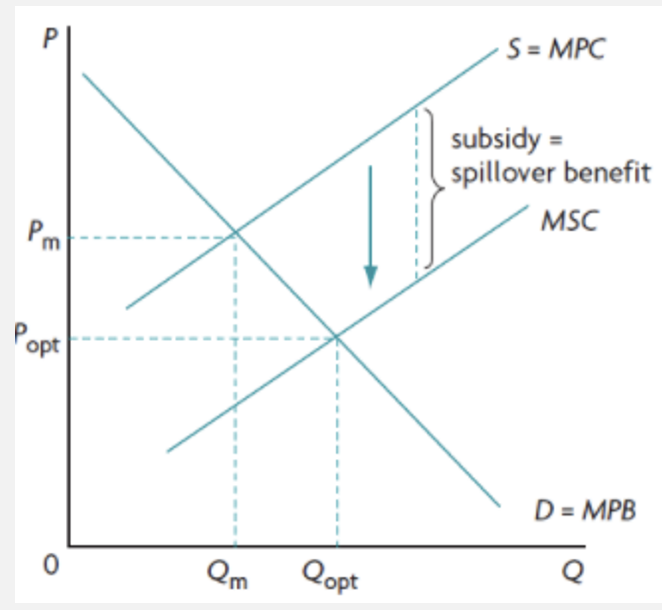
positive consumption externalities
the external benefits created by consumers
eg: consumption of education spills over into society in the form of higher productivity, lower unemployment and higher rate of economic growth.
positive consumption externalities graph
when MSB > MPB
Qm < Qopt and MSB > MSC so the market is under-allocating resources and not enough is consumed
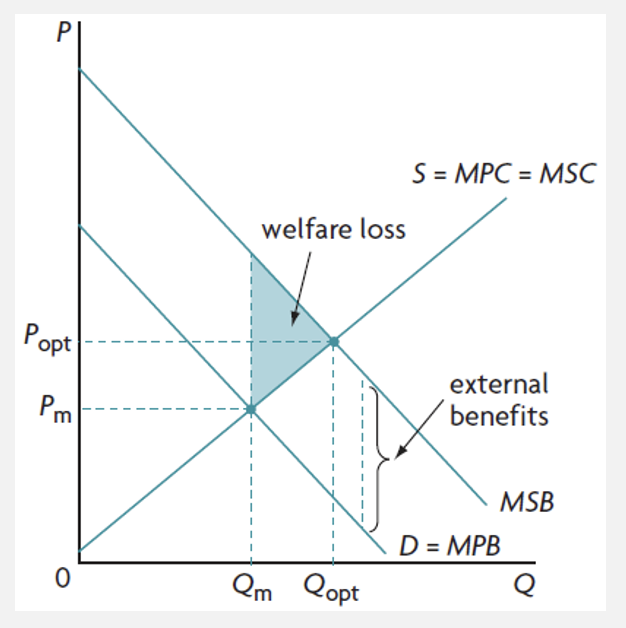
ways to correct PCE (increase demand)
govt regulation: make certain services compulsory
education and awareness creation: inform consumers of benefits
nudges: Create incentives to stimulate adoption of goods/services that increase spillover benefits
INCREASE IN PRICE
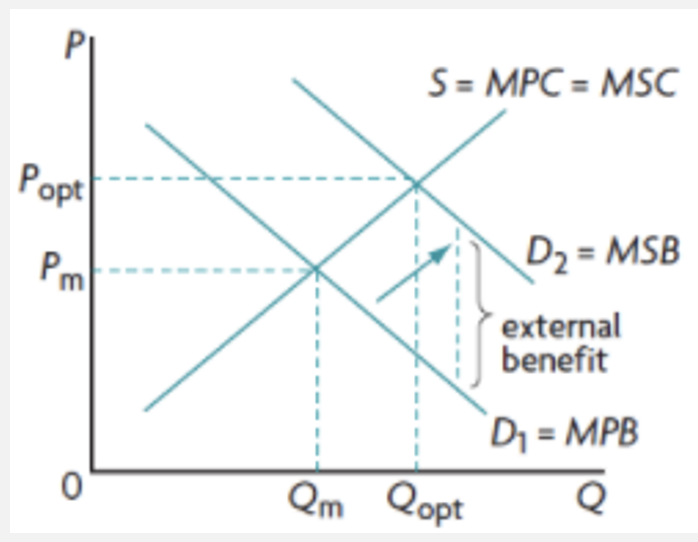
ways to correct PCE (increase supply)
direct govt provision: provide merit goods to increase supply and reduce the amount that is under-allocated
subsidies: increases supply of the good/service, reducing the under allocation
DECREASE IN PRICE
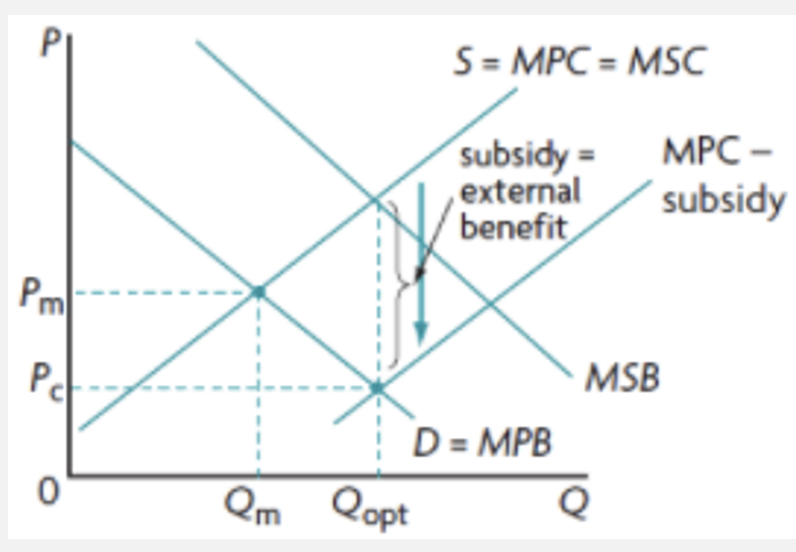
consequences of legislation, education and awareness creation
limitations with regards to calculating the size of the external benefit
increase price for consumers, making some g/s unaffordable
best used in conjunction with direct provision and subsidies
consequences of direct govt provision and subsidies
effective in increasing the quantity of a g/s + lowering price for consumers
opportunity cost
difficult to measure size of external benefit
public goods
goods that are non-excludable and non rivalrous:
non-excludable: not possible to exclude someone from using the good
non-rivalrous: the consumption by one person does not reduce consumption by someone else
the free rider problem
when people can enjoy the use of a good without paying for it.
market failure of public goods
form of market failure because private firms don’t produce them, so are underproduced
market fails to allocate resources to their production
consequences of direct government provision
due to opportunity cost there are issues in determining which and how much of these public goods to provide
Economic criteria should be used but it is difficult to estimate expected benefits- no market price for public goods
Votes, surveys are used instead to estimate the “cost-benefit”. Problem- people will exaggerate the need or value
consequences of contracting out to private sector
competitive tendering- lowest cost provider will be selected
better quality control
access to broader range of skills/technology than the govt
private firm may be more flexible/innovative
govt becomes less accountable
govt loses control
cost may be greater
monitoring adds to costs
asymmetric information
occurs when there is missing information and buyers and sellers don’t have equal access to information
adverse selection (seller knows more)
weary consumers are often aware or skeptical which means they will be more cautious
results in less demand, thus less production (underallocation)
if consumers are unaware and trust the seller there will be overconsumption (overallocation)
government responses to adverse selection
regulation: pass laws that ensure quality standards and safety features that must be maintained
time-consuming
provision of info: govt provides or forces producers to provide info
time-consuming, opportunity cost, info may not be entirely accurate
licensure: govts can require producers to be licensed to practice, sell goods, offer services
private responses to adverse selection
screening: used by the buyer so buyers can get more info on their purchases. information about sellers can be posted online
signalling: used by the sellers so they can convince buyers that the g/s can be trusted. may provide warranties or return policies that increase trust
adverse selection (buyer knows more)
often rises when buying health insurance
results in less supply since the seller is weary of information being withheld so less is offered which makes it more expensive and less people take it up (underallocation).
moral hazard
happen when one party changes their behavior after obtaining an insurance
responses: making the insurance taker pay for part of the costs, regulation and monitoring by the govt
why the free market results in income inequalities
arise from the difference in education, skills and general ownership of assets and wealth.
distribution of factors such as land, capital and entrepreneurial abilities is generally unequal in a society based on a market-determined distribution.
so, income distribution will be unequal and it would be up to the government to redistribute these so that the outcome is fairer
inequality in wealth
refers to the money or things of value that people own. eg: stocks, land, houses, paintings or jewelry.
income- possibility of saving- rise to creation of wealth
high income, low wealth- spend a lot
low income, high wealth- inherited assets